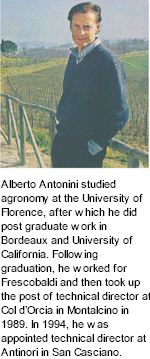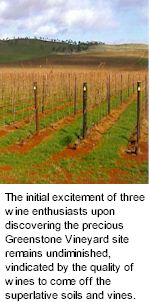


Alberto Antonini and David Gleave have known each other since meeting in Montalcino in 1989. Both make their living from Italian wine - Alberto as a winemaker, consultant and grapegrower, David as the UK importer of some of Italy's top producers - yet they have often discussed over the years the great allure of Australia and Australian wine. The styles of wine, and the freedom to plant and develop whatever variety you believe is going to work in your piece of land, is of great appeal to them both. So when Mark Walpole took Alberto Antonini, whom he knew through their shared interest in Italian grape varieties in Australia, to visit the Greenstone site, Alberto wasted no time in ringing David in London. Alberto was struck by the quality of the soil and site. “I’m standing on a hill in Heathcote that would make a great vineyard,” he said to David. That was all it took to set the Greenstone Vineyard in motion.

The 40 hectare Greenstone Vineyard is situated north of Heathcote at Colbinabbin. Heathcote lies just north of the Great Dividing range in the Central Highlands region of Victoria at an altitude of around 400 metres. The region, while warmer and more continental than districts south of the Great Dividing Range, still enjoys some cooler temperatures due to the prevailing cool south to southeast winds that sweep over the Tooborac hills that stretch the whole length of the Mt Camel Range. These winds occur during the period from October to March, which coincides with the vines’ growing period.
The Greenstone Vineyard is on the ridge of old Cambrian soil that runs through the eastern side of the Camel ranges. The 500 million year old Cambrian soils are unique in Australia in that they are volcanic in origin yet contain high levels of calcium. They are low in vigour, so ideally suited to the production of quality wine.
The name ‘Greenstone’ comes from the greenish rocks that are so plentiful in the vineyard. The colour of these rocks is derived from oxidised iron. The high level of iron in the soil is responsible for the red earth for which Heathcote is famous. This soil, one of the oldest in Australia, is rich in calcium with a high pH (over 7), a combination that results in wines of great elegance.

Mark Walpole was first attracted to the red soil of Heathcote when, as a ten year old, he travelled with his family over the Camel ranges and was struck by the red wool on the sheep that grazed on the Cambrian soils. Years later, as chief viticulturalist for Brown Brothers, he was one of the first people to recognise the great potential that existed in Heathcote for quality red wine when he developed their Patricia vineyard, which is five kilometres north of the Greenstone site.
The first 10 hectares of Shiraz were planted in 2003, while the following year saw the planting of one hectare each of Tempranillo and Monastrell as well as a further 8 hectares of Shiraz. Mark chose four different Shiraz clones for the vineyard, three from the Barossa (1654, 2626 and 1127) and one from Coonawarra (R6WV28). Mark and Alberto met through their shared passion for Italian varieties, so it is only fitting that Sangiovese should have been planted. The clones were selected by Alberto in Italy, and are the best of the new Tuscan clones selected and propagated by the Rauscheder nursery in Italy. Both are convinced that Tempranillo and Monastrell will perform as well in Heathcote as they do in their native Spain. The vine density is 4,500 vines per hectare, about twice the average in the rest of Heathcote. This high density reduces the vines’ vigour, and gives a lower yield per vine which, results in better quality grapes.
Another innovation introduced by Mark and Alberto was to plant the rows in an east-west rather than north-south direction. The orientation of the rows protects the grapes against the fierce summer sun, ensuring a more gradual ripening process and resulting in livelier and more elegant fruit in the wines. The grapes are hand harvested in mid March and then transported to the Kooyong winery in the Mornington Peninsula. Sandro Mosele, the winemaker at Kooyong, works in conjunction with Alberto Antonini to make the Greenstone wines.
